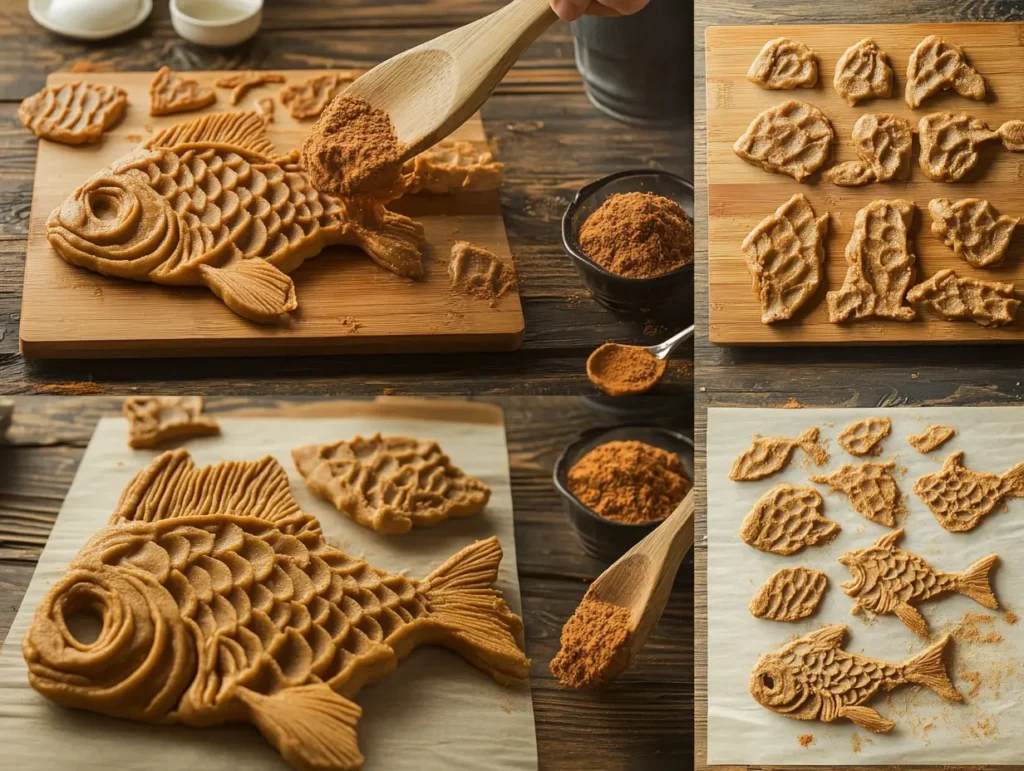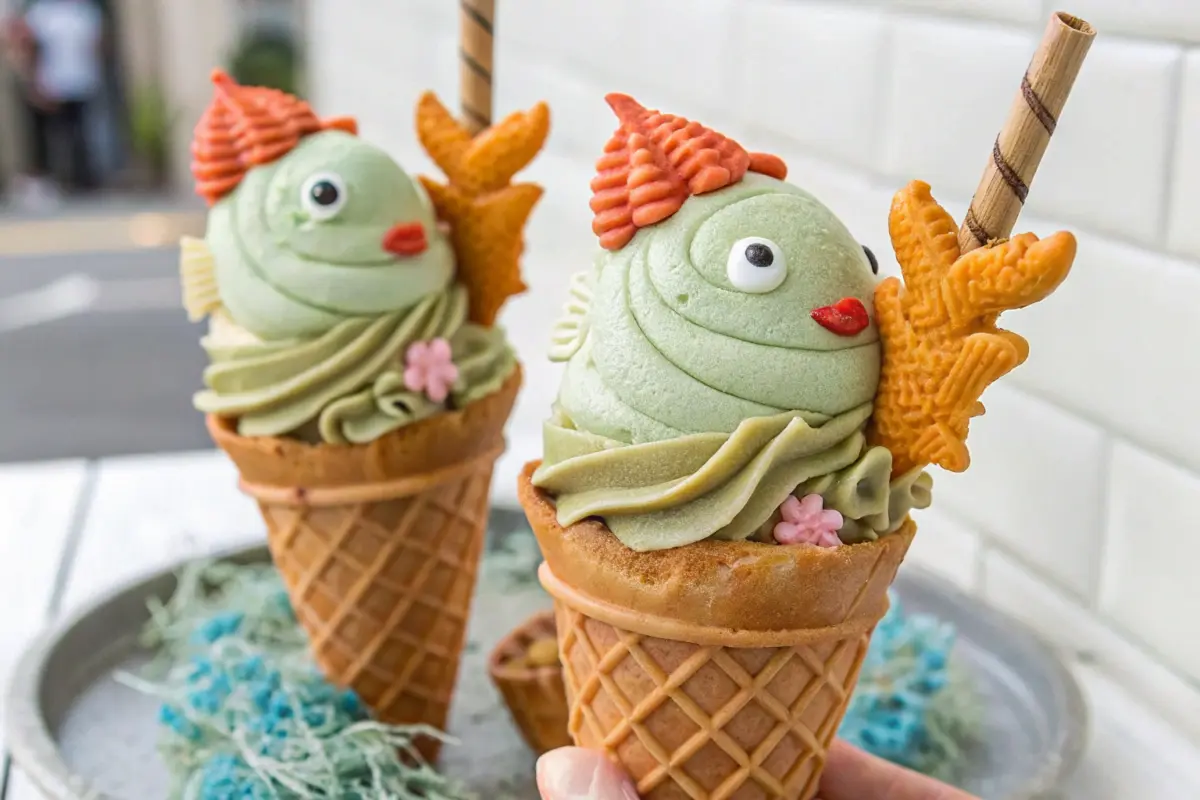Japanese cuisine is renowned for its unique and delightful creations, and Taiyaki is a perfect example of this culinary artistry. Shaped like a charming fish, this beloved treat wins over both hearts and palates with its irresistible flavors and playful design. But despite its appearance, Taiyaki isn’t what it seems—it’s not made of fish at all! This article explores the story behind Taiyaki, from its origins to its symbolic design, cultural significance, and modern adaptations. Let’s dive into the fascinating world of Taiyaki.
Table of Contents
Introduction to Taiyaki – What Kind of Fish is Taiyaki?
What is Taiyaki? – Understanding the Fish-Shaped Pastry
Taiyaki is a quintessential Japanese street food that has enchanted locals and tourists alike. It’s a warm, fish-shaped pastry filled with various delicious fillings, such as sweet red bean paste. Despite its resemblance to tai (red sea bream), Taiyaki isn’t made of fish but rather of batter, akin to a pancake or waffle. Its whimsical design and comforting flavors make it a staple in Japanese festivals and street markets.
Literal Meaning of Taiyaki – What Kind of Fish is Taiyaki?
The name Taiyaki directly translates to “baked sea bream” (tai meaning red sea bream, and yaki meaning grilled or baked). This name pays homage to the auspicious tai, a fish revered in Japanese culture for symbolizing good fortune and celebration. Although Taiyaki imitates the fish’s shape, its true essence lies in being a sweet or savory delight, far removed from actual seafood.
History and Origin of Taiyaki – The Story Behind the Fish Shape

The Beginnings in the Meiji Era – Taiyaki’s Cultural Roots
The story of Taiyaki begins in the late Meiji era (1868–1912) in Japan, during a time of transformation and modernization. As street vendors sought creative ways to attract customers, the humble fish-shaped confection was eventually born. Interestingly, this delightful snack was modeled after imagayaki, which is a round pastry filled with sweet red bean paste. By shaping it like the auspicious tai, vendors not only elevated its appeal but also quickly made it a favorite among locals. Over time, the unique design and symbolism of Taiyaki helped it stand out in the bustling streets of Japan.
So, what kind of fish is Taiyaki? Well, none! Despite its name, Taiyaki doesn’t involve any seafood. Instead, the fish shape nods to cultural symbols of prosperity. Over time, Taiyaki became a hit at festivals and markets, eventually embedding itself as a beloved street food.
Evolution of Taiyaki – From What Kind of Fish is Taiyaki? to a Global Treat
Taiyaki’s appeal wasn’t limited to its unique look—it also became a symbol of joy and celebration. The cheerful fish design captured hearts, and its comforting fillings suited any palate. As Japan urbanized, Taiyaki stalls spread across cities, making it a nostalgic treat for many.
Today, Taiyaki is more than just a snack; it’s a cultural icon. Whether enjoyed on chilly winter nights or as part of a bustling summer festival, Taiyaki connects people to a shared history of happiness and indulgence.
Composition and Ingredients – What Makes Taiyaki Special?
Batter Basics – The Foundation of Taiyaki
Taiyaki’s base is simple yet versatile. The batter, resembling pancake or waffle mix, creates a soft yet crisp outer shell. It’s this golden crust that holds the magic inside. Unlike other pastries, Taiyaki is cooked in cast iron molds, giving it a distinctive texture and fish shape.
Traditional Fillings – Exploring Taiyaki’s Heart
Classic Taiyaki is filled with anko, a sweet red bean paste cherished in Japanese desserts. This traditional filling balances the pastry’s light sweetness, creating a satisfying harmony of flavors. For purists, anko is the heart of Taiyaki.
Modern Twists – Adapting the Classic Fish Pastry
But over the years, Taiyaki has evolved significantly. Today, its fillings range from traditional red bean paste to modern options like custard and chocolate, and even savory choices such as cheese and curry. As a result, these innovations cater to a wide variety of tastes, ensuring Taiyaki stays both relevant and exciting. Moreover, its adaptability has turned it into a global sensation, with variations uniquely tailored to local preferences.
Despite these modern twists, the essence of Taiyaki remains unchanged—a delightful, fish-shaped treat deeply rooted in tradition. Ultimately, the answer to what kind of fish is Taiyaki remains constant: it’s a whimsical confection, not a seafood dish.
The Symbolism of the Fish Shape – Why Taiyaki Looks Like a Fish
Why Sea Bream? – The Cultural Significance of Tai in Taiyaki
One of the most striking aspects of Taiyaki is its fish shape, designed to resemble a red sea bream (tai). In Japanese culture, this fish is a symbol of good luck and prosperity. It’s no surprise that Taiyaki adopts this form—its very design evokes feelings of celebration and fortune. So, what kind of fish is Taiyaki? The answer is simple: it’s inspired by tai, but it’s all about the symbolism, not the seafood.
The shape also aligns with the Japanese concept of auspicious motifs, which are believed to bring blessings. By serving Taiyaki in the shape of a sea bream, vendors ensure their customers feel the charm and tradition in every bite.
Artistic Influences – What Kind of Fish is Taiyaki? in Design
Taiyaki’s design is both practical and artistic. The fish-shaped molds create a crisp, golden crust that holds the filling perfectly. Over the years, the design has also allowed for creative adaptations, like mini Taiyaki or even versions featuring cartoon characters. These variations demonstrate how Taiyaki has evolved while keeping its cultural roots intact.
For more unique twists on traditional recipes, check out this guide to creative pancake desserts.
Taiyaki’s Global Reach – How the Fish Pastry Conquered the World
Taiyaki Around the Globe – Modern Variations of the Classic
Taiyaki’s appeal has gone far beyond Japan’s borders. From Korean bungeoppang to fish-shaped ice cream cones in the West, its essence has inspired countless adaptations. In countries like the U.S. and Australia, Taiyaki is often filled with soft-serve ice cream, giving it a modern, trendy twist. Despite these changes, its connection to Japan’s culinary heritage remains intact.
Fusion Foods – The Global Appeal of Taiyaki’s Design
The concept of fish-shaped desserts has become a canvas for global creativity. Fusion foods, like matcha-filled Taiyaki or savory versions with cheese and kimchi, demonstrate its adaptability. This universal appeal is a testament to Taiyaki’s enduring charm.
If you’re intrigued by unique fish-inspired dishes, you might also enjoy exploring the world of fish ice cream.
Making Taiyaki at Home – Recreate the Fish Pastry Experience

Essential Tools – What You Need for Taiyaki
Creating Taiyaki at home is easier than you think, as long as you have the right tools. The key piece of equipment is a fish-shaped mold, typically made of cast iron or non-stick material. These molds ensure the pastry’s signature look while helping it cook evenly. You’ll also need basic kitchen tools like a mixing bowl, whisk, and spatula.
If you’re wondering, what kind of fish is Taiyaki? Remember, the mold gives it the fish shape, not the ingredients—making this dessert whimsical and fun to prepare.
Step-by-Step Guide – What Kind of Fish is Taiyaki? at Home
- Prepare the Batter: Combine pancake or waffle mix with water, eggs, and a little sugar to form a smooth batter.
- Heat the Mold: Preheat the fish-shaped mold on medium heat and lightly grease it with oil or butter.
- Pour the Batter: Fill half of the mold with batter, ensuring it spreads evenly.
- Add the Filling: Spoon a dollop of sweet red bean paste, custard, or any filling you love into the center.
- Seal and Cook: Cover the filling with more batter, close the mold, and cook until golden brown on both sides.
This delightful treat brings a taste of Japan to your home kitchen, and you can customize it to suit your tastes.
For more helpful tips on batter preparation, check out this guide to pancake recipes.
Frequently Asked Questions
Is Taiyaki Made from Fish?
No, Taiyaki contains no fish. Its name and shape come from the tai (red sea bream), a fish symbolizing luck and prosperity in Japan. So, what kind of fish is Taiyaki? None! It’s simply a sweet or savory pastry with a charming fish-shaped design. For a fun twist on fish-shaped desserts, check out what is Korean fish ice cream called or explore what is fish ice cream to discover more unique treats.
What is the Best Filling for Taiyaki?
The classic filling for Taiyaki is anko, or sweet red bean paste. However, modern variations include custard, chocolate, cheese, and even ice cream. The best filling depends on your personal taste, but red bean paste remains a timeless favorite.
Can Taiyaki Be Made Vegan or Gluten-Free?
Yes, Taiyaki can be adapted to suit dietary needs. Vegan versions use plant-based milk and egg substitutes, while gluten-free batters work well with alternative flours. These adaptations keep Taiyaki accessible to everyone.
Taiyaki’s versatility ensures it remains a beloved treat for all occasions. Whether traditional or modern, sweet or savory, this fish-shaped pastry delights fans worldwide. Ready to explore more Japanese delights? Stay tuned for similar recipes in our upcoming articles!

